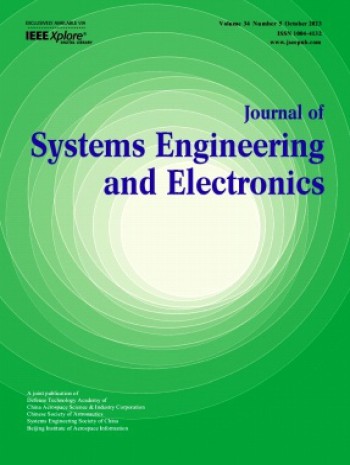
影响因子:0.641
复合影响因子:0.96
主管单位:中国航天科工集团
国内刊号:11-3018/N
创刊时间:1990
国际刊号:1004-4132
邮发代号:82-270
业务类型:期刊征订
学术咨询: 预计审稿时间: 1-3个月 影响因子:0.641
选定期刊
支付定金
确认完成服务
支付尾款
《Journal of Systems Engineering and Electronics》是《中国科学引文数据库》来源期刊,被美国科学引文索引(SCIE)、美国工程索引(EI)和英国科学文摘(SA)等多家国内、外著名检索系统收录。
《Journal of Systems Engineering and Electronics》是面向高科技开发和应用的跨学科期刊,以传播新技术、促进学术交流为宗旨,坚持深度与广度、理论与应用相结合的方针,努力反映系统工程与电子技术两大领域的最新成就,报道的主要内容包括:系统科学、军事系统分析、飞行器控制、雷达、光电探测技术、信息获取与处理、运筹学管理与决策技术等。
文摘与引文数据库维普收录(中)剑桥科学文摘SCI 科学引文索引(美)上海图书馆馆藏国家图书馆馆藏万方收录(中)SA 科学文摘(英)EI 工程索引(美)知网收录(中) 中国优秀期刊遴选数据库中国期刊全文数据库(CJFD)
系统工程 电子技术 军用系统分析 防御电子技术 控制理论与实践 软件 算法与仿真 计算机开发与应用
Aims and scope
The journal, keeping abreast with the development trend of science and technology worldwide, reports the latest developments and achievements in systems engineering and electronics and related research areas, and encourages various academic views. The journal welcomes papers from a wide variety of countries.
The journal strives to publish high-quality papers reporting original work in both theoretical and practical research results within the journal scope, involving system analysis, system modeling and simulation, military system analysis, aircraft control, C3I, radar, information systems engineering, machine intelligence, artificial neural networks, information acquisition and processing, aerospace electronics, and other topics in all related fields.
Title
The title is centered on the page and should be short and concise. Please limit the title to a maximum length of 10 words. The author’s name follows and is also centered on the page. The author’s last name should be preceded by the other names spelled out in full. The author’s affiliation and address are also needed.
The corresponding author should be clearly indicated with the asterisk (i.e., *) and given on the bottom of the first page. Please provide the financial support acknowledgments (name and number) on the bottom of the first page.
Abstract
An abstract, not exceeding 200 words, is required for all papers. Acronyms and abbreviations are spelled out at first mention in the abstract. It should be a summary of the paper and not an introduction. Because the abstract may be used in abstracting journals, it should present concisely the purposes, methodology used, results obtained, and conclusions.
Keywords
The author must provide a list of keywords, up to a maximum of six. No acronyms and abbreviations should be used.
Text
Text should be typed in double-column. The introduction of paper should explain the nature of the problem, previous work, purpose, and contribution of the paper. It is assigned the number “1” and following sections are assigned number as needed. For example, the third section of a paper might be “3. Simulation results” headings. Acronyms and abbreviations are spelled out at first mention in the text, even they have already been defined in the abstract.
Figures and tables
The authors must ensure figures of sufficient quality and resolution. Figure captions appear below the figures. Figures should be numbered in the order they appear in the text. Table titles appear above the tables. Please verify that the figures and tables you mention in the text actually exist. When referring to a figure or a table in the text, use the abbreviation “Fig.” even at the beginning of a sentence, and do not abbreviate “Table”.
Equations
Number equations consecutively with equation numbers in parentheses flush with the right margin, as in (1). Be sure that the symbols in the equation have been defined before the equation appears or immediately following. When referring to “(1)”, do not use “Eq. (1)” or “equation (1),” except at the beginning of a sentence: “Equation (1) is ...”.
Conclusion
A conclusion must be included and should indicate clearly the advantages, limitations, and possible applications of the paper.
Acknowledgment
Individuals or units other than authors who were of direct help in the work should be acknowledged by a brief statement following the conclusion. This heading is not assigned a number.
References
Only articles that have been published may be included in the references. Each reference is referred to in the text by a number enclosed in a square bracket (i.e., [3]). References must be numbered and ordered according to where they are first mentioned in the paper. A reference list must be included using the following information as a guide.
Biographies
Short biographies (120-150 words) should be provided that detail the authors’ education, work histories and research interests as well as their E-mail. The authors’ full names are needed. Small (2.5 cm×3.5 cm), black-and-white and high- resolution (300 dpi) photos of each author should be included.
该期刊创刊于1990年,出版地方是北京,先后获得中国优秀期刊遴选数据库、中国期刊全文数据库(CJFD)、等荣誉,是一本有一定影响力的学术期刊。
该期刊国际刊号:1004-4132,国内刊号:11-3018/N。相关信息可以在国家新闻出版总署网站上查询。如果您还有疑问,可以联系客服,了解更多详情。
影响因子现已成为国际上通用的期刊评价指标,它不仅是一种测度期刊有用性和显示度的指标,而且也是测度期刊的学术水平,乃至论文质量的重要指标。该期刊影响因子为0.641,复合影响因子为0.96。
根据出版周期的不同,期刊通常可分为月刊、双月刊、季刊、半年刊、年刊、双年刊等。该杂志的发行周期为双月刊。发行周期会影响到文章的排期,如果您有需要,请尽早与我们联系。
本站合法持有《出版物经营许可证》,仅销售经国家新闻出版署批准的合法期刊,不是任何杂志官网,不涉及出版事务。本站仅提供有限咨询服务,需要用户自己向出版商投稿且没有绿色通道,是否录用一切以出版商通知为准。提及的第三方名称或商标,其知识产权均属于相应的出版商或期刊,本站与上述机构无从属关系,所有引用均出于解释服务内容的考量,符合商标法规范。本页信息均由法务团队进行把关,若期刊信息有任何问题,请联系在线客服,我们会认真核实处理。 若用户需要出版服务,请联系出版商,地址:北京142信箱32分箱,邮编:100854。